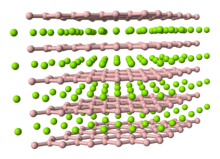Hafnium diboride
Hafnium diboride belong to the class of Ultra-high-temperature ceramics, a type of ceramic composed of hafnium and boron. It has a melting temperature of about 3250 degrees Celsius. It is an unusual ceramic, having relatively high thermal and electrical conductivities, properties it shares with isostructural titanium diboride and zirconium diboride. It is a grey, metallic looking material. Hafnium diboride has a hexagonal crystal structure, a molar mass of 200.11 grams per mole, and a density of 10.5 grams per cubic centimeter.
 | |
| Identifiers | |
|---|---|
3D model (JSmol) |
|
| ChemSpider | |
| ECHA InfoCard | 100.031.351 |
PubChem CID |
|
CompTox Dashboard (EPA) |
|
| |
| |
| Properties | |
| HfB2 | |
| Molar mass | 200.11 g/mol |
| Density | 10.5 g/cm3 |
| Melting point | ca. 3,250 °C (5,880 °F; 3,520 K) |
| Structure | |
| Hexagonal, hP3 | |
| P6/mmm, No. 191 | |
Except where otherwise noted, data are given for materials in their standard state (at 25 °C [77 °F], 100 kPa). | |
| Infobox references | |
Hafnium diboride is often combined with carbon, boron, silicon, silicon carbide, and/or nickel to improve the consolidation of the hafnium diboride powder (sintering). It is commonly formed into a solid by a process called hot pressing, where the powders are pressed together using both heat and pressure.
The material has potential for use in hypervelocity reentry vehicles such as ICBM heat shields or aerodynamic leading-edges, due to its strength and thermal properties. Unlike polymer and composite material, HfB2 can be formed into aerodynamic shapes that will not ablate during reentry.
Hafnium diboride is also investigated as a possible new material for nuclear reactor control rods. It is also being investigated as a microchip diffusion barrier. If synthesized correctly, the barrier can be less than 7 nm in thickness.
Nanocrystals of HfB2 with rose-like morphology were obtained combining HfO2 and NaBH4 at 700-900°C under argon flow:[1]
HfO2 + 3NaBH4 → HfB2 + 2Na(g,l) + NaBO2 + 6H2(g)
References
- Zoli, Luca; Galizia, Pietro; Silvestroni, Laura; Sciti, Diletta (23 January 2018). "Synthesis of group IV and V metal diboride nanocrystals via borothermal reduction with sodium borohydride" (PDF). Journal of the American Ceramic Society. doi:10.1111/jace.15401.